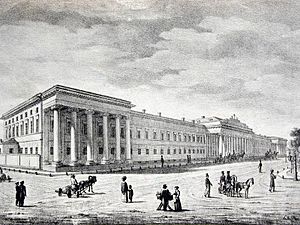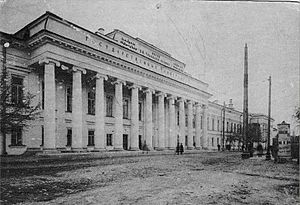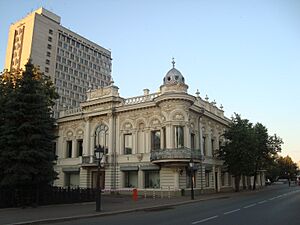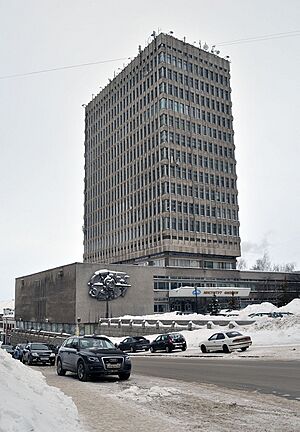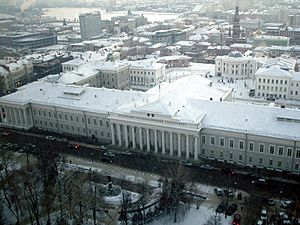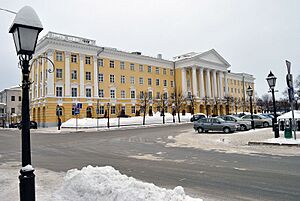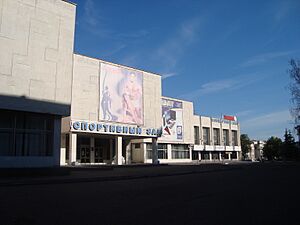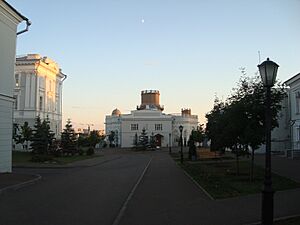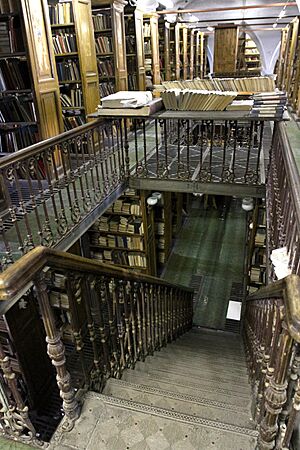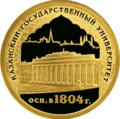Kazan Federal University facts for kids
|
Казанский (Приволжский) федеральный университет
|
|
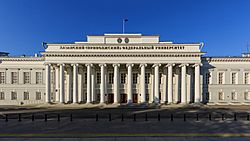 |
|
| Latin: Universitas Casanensis | |
|
Former names
|
Vladimir Ulyanov-Lenin Kazan State University, Imperial Kazan University |
|---|---|
| Type | Public/Federal university |
| Established | November 17, 1804 |
| Rector | Lenar Safin |
|
Academic staff
|
~ 4400 |
| Students | ~ 50200 |
| Address |
18 Ulitsa Kremlevskaya
,
,
,
Russia
55°47′27″N 49°07′19″E / 55.7907°N 49.1219°E |
| Campus | Both urban and suburban |
| Language | Russian, English, Tatar |
| Colours | Blue and white |
| Affiliations | EUA IAU EURAS AMBA |
| Website | eng.kpfu.ru |
 |
|
Kazan Federal University is a big public university in Kazan, Russia. It is also known as KFU. It is a place where students learn and researchers discover new things.
The university started way back in 1804. This makes it the second oldest university in Russia that has been open continuously. Famous people like Nikolai Ivanovich Lobachevsky, who created non-Euclidean geometry, were rectors here. Vladimir Ilyich Ulyanov (Lenin), a future leader, was also a student. KFU is famous for being the birthplace of organic chemistry and for the discovery of electron spin resonance.
In 2011, Kazan University became a federal university. It is part of a special project to help Russian universities become more competitive globally. As of early 2023, over 52,000 students were studying at KFU. About 11,500 of these students came from other countries. The university focuses on research in areas like medicine, new materials, energy, and computer science.
Contents
History of Kazan Federal University
Kazan University has a rich history filled with important discoveries and famous people. Many great minds studied or worked here.
Key Discoveries and Famous People
Many important discoveries happened at Kazan University. Nikolai Lobachevsky developed non-Euclidean geometry here. Karl Ernst Claus discovered the chemical element Ruthenium. The theory of chemical structure was created by Aleksandr Butlerov. Yevgeny Zavoisky discovered electron paramagnetic resonance.
Many famous people were students or alumni. These include Vladimir Lenin, who later founded the Soviet Union. Writers like Leo Tolstoy and Sergei Aksakov also studied here. The composer Mily Balakirev and painter Valery Yakobi are also alumni.
Early Years of the University
Kazan University officially opened on November 17, 1804. This happened when Emperor Alexander I signed a special document. The first students joined in 1805. They came from the First Kazan Gymnasium.
At first, the university was part of Moscow State University. It fully opened in 1814. It had four main study areas: moral and political sciences, math and physics, medical sciences, and languages. For a long time, it was the easternmost university in the Russian Empire. It served a huge area, including Siberia.
In 1819, a review of the university found some problems. The Emperor decided to fix them instead of closing the university. This led to some changes, including new rules for students.
In 1819–1821, a scholar from Kazan University, Ivan Simonov, helped discover Antarctica. He was part of the first trip around the world.
The main university building was finished in 1825. By 1830, the whole campus was complete. This included the library, labs, an observatory, and clinics. Science subjects became very strong here.
In 1834, the university started publishing its own journal. In 1835, new departments were created. These included Philosophy, Law, and Medicine.
In 1844, Professor Karl Ernst Claus discovered Ruthenium. He named it after Russia. This was the only chemical element discovered in Tsarist Russia. Later, in 1863, the university was reorganized into four main departments. These were History and Philology, Physics and Mathematics, Law, and Medicine.

Vladimir Ilyich Ulyanov (Lenin) studied law at the university in 1887. He was expelled in December 1887 due to student protests.
The university faced big challenges during the Russian Civil War (1918). Many students and teachers left Kazan. Some of them helped start new universities in Siberia.
Women's Education at Kazan University
From 1859, women were allowed to attend university lectures. However, special courses for women were not funded by the government. They were expensive. In 1876, the government allowed Higher Women's Courses in cities with universities.
From October 1876, women could enroll in evening classes at Kazan University. They needed to have finished a girls' high school or pass an exam. Students took courses in art history, physics, Russian history, and literature. They could also choose other subjects like languages and math.
In 1879, the courses expanded to include science and math. This meant more options like algebra, chemistry, and natural sciences. The courses allowed women to get higher education for ten years. They closed in 1886.
In 1906, after a revolution, the university was allowed to bring back the Higher Women's Courses.
Kazan University in the Soviet Era
After 1918, the university changed. All lecturers with three years of experience could become professors. This helped the university restart teaching and research after losing many staff during the civil war.
The university opened a 'workers' faculty'. This was to provide education for peasants without entrance exams. In 1925, the university was renamed V. I. Ulyanov-Lenin Kazan State University. This was to honor Vladimir Lenin who had been a student there.
In the 1930s, some parts of the university became separate institutions. For example, Kazan State Medical University started this way. During World War II (1941–1943), many scientists from Moscow and Leningrad came to Kazan University. This led to the creation of the Kazan Department of the Academy of Sciences in 1945.
After the war, Kazan University grew a lot. It received awards for its work in education. New tall academic buildings were built in the 1970s for Physics and Mathematics. A large sports and concert hall, UNICS, opened in 1989.
Kazan University in the 21st Century
On October 21, 2009, Russian President Dmitry Medvedev signed a decree. This created a new Volga Federal University based on Kazan State University. Other local universities joined it.
In 2013, Kazan Federal University started a program to improve its global ranking. This was part of a government plan to make Russian universities more competitive. KFU is now part of a new project called Priority 2030.
University Rankings and Reputation
KFU has worked hard to improve its standing among universities worldwide. It has been ranked by different global systems.
KFU has been in the QS World University Rankings since 2012. It has steadily moved up the list. In November 2020, it was the only Russian university to get 5+ stars in QS Stars Ratings. KFU also appeared in the Academic Ranking of World Universities in 2018.
The university is also ranked in many specific subject areas. These include rankings by QS and Times Higher Education.
University Campus
Kazan Federal University's main campus is in downtown Kazan. It is just a 10-minute walk from the Kazan Kremlin. The main building was designed in the 1820s. It has a classic look with white walls.
From 1832 to 1841, more buildings were added. These included the Library, Chemical Laboratory, and an astronomical observatory. The campus has grown over the years. A new laboratory building was added in 2015.
In 1996, the university's buildings were added to Russia's National Cultural Heritage Register. This means they are protected because of their historical importance. Today, the main building houses the university administration and several museums. These include the Museum of History of Kazan University and the Zoology Museum.
KFU's student dorms are in the Universiade Village. This village was built for the 2013 World Summer Universiade sports event. The university also has facilities in other parts of Russia and even in Turkey.
How Kazan Federal University is Organized
Kazan Federal University has its main campus in Kazan. It is made up of 15 institutes, 1 faculty, and 1 higher school. The university also has three smaller branches in other cities. These branches offer many different study programs.
The university mostly teaches in Russian. Students who want to learn Russian or English can join KFU's Preparatory School. Some programs are taught in English, like a six-year medical course.
Main Study Areas
KFU offers many subjects. They are grouped into different institutes:
- Physics, Mathematics, and IT
- Institute of Physics
- N.I. Lobachevsky Institute of Mathematics and Mechanics
- Institute of Computational Mathematics and Information Technologies
- Institute of Information Technologies and Intelligent Systems
- Institute of Engineering
- Natural Sciences
- Institute of Geology and Petroleum Technologies
- Institute of Fundamental Medicine and Biology
- Institute of Environmental Sciences
- Alexander Butlerov Institute of Chemistry
- Humanities
- Institute of Philology and Intercultural Communication
- Institute of Social and Philosophical Sciences and Mass Communications
- Institute of International Relations
- Institute of Psychology and Education
- Faculty of Law
- Institute of Design and Spatial Arts
- Economics and Public Administration
- Institute of Management, Economics and Finance
- Higher School of Business
There are also other units that offer special training. These include the Department of Physical Education and Sports.
Working with Other Countries
Kazan University has always had strong international connections. Some of its first teachers were from Germany. Karl Fuchs, a German professor, became the university's rector in the 1820s. He also studied Tatar history and culture.
KFU works with about 190 universities and research centers. These partners are in more than 53 countries. This cooperation helps KFU take part in research programs. It also allows for double degree programs, where students can earn degrees from two universities.
In the 2015–2016 school year, about 3000 international students studied at KFU. Each year, many KFU students and teachers visit foreign universities. They go for conferences and research. Many international experts also visit KFU for scientific events.
Native speakers teach different foreign languages at KFU. These include Chinese, Korean, German, and English. Many famous scientists and Nobel Prize winners have been honorary doctors or professors at KFU.
KFU works on big projects with support from the Russian Government. These projects involve research in areas like neurobiology and new materials. The university also works with companies to develop new technologies.
Kazan University has also been part of European cooperation programs like Tempus and Erasmus. These programs give students and staff chances to train at top European universities.
University Library
The Nikolai Lobachevsky Scientific Library at Kazan University has amazing collections. It holds 15,000 manuscripts and 3,000 rare books. It opened in 1809. Some of its first books came from Count Grigori Alexandrovich Potemkin. Later, books from the Solovetsky Monastery were added.
These old books are kept in a special part of the library. This collection includes Arabic manuscripts from the 11th century. There is also a copy of the Pentateuch and early printed books from 1518. The library has first editions of books by famous Russian writers like Pushkin and Leo Tolstoy. It also has old newspapers and books about Kazan. The original library building was built between 1825 and 1833. The university's rector, N. Lobachevsky, was also the chief librarian at that time.
Notable People from Kazan Federal University
Many important people in different fields have been connected to Kazan Federal University.
Leaders and Public Figures
- Sergey Aksakov
- Vladimir Lenin (expelled)
- Alexei Rykov
- Nikolai Semashko
Scientists and Mathematicians
- Aleksandr Arbuzov
- Aleksandr Butlerov
- Nikolay Lobachevski
- Vladimir Markovnikov
- Karl Ernst Claus
- Yevgeny Zavoisky
- Semen Altshuler
Artists and Musicians
- Mily Balakirev
- Stanislav Govorukhin
- Karl Fuchs
- Yuliya Zaripova
Writers
- Pavel Melnikov-Pechersky
- Velimir Khlebnikov
- Leo Tolstoy
Images for kids
-
Annual celebration of the birthday of Nikolay Lobachevsky by participants of Volga's Mathematical Olympiad of students
See also
 In Spanish: Universidad Federal de Kazán para niños
In Spanish: Universidad Federal de Kazán para niños
- Education in Russia
- List of universities in Russia



